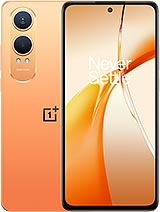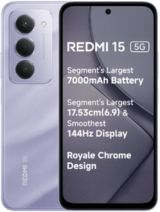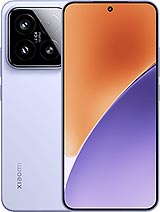Redmi 15 alternatives
Tap above to see alternatives.
Xiaomi 15 alternatives
Tap above to see alternatives.
2x2.3 GHz Cortex-A78
6x2.0 GHz Cortex-A55
2x4.32 GHz Oryon V2 Phoenix L
6x3.53 GHz Oryon V2 Phoenix M
8GB 128GB (UFS 2.2)
8GB 256GB (UFS 2.2)
f/1.75, (wide), 1/2.88" 0.61μm, PDAF
Auxiliary lens
f/1.6, 23mm (wide), 1/1.31", 1.2µm, OmniVision Light Fusion 900, dual pixel PDAF, OIS
50 MP
f/2.0, 60mm (telephoto), 1/2.76", 0.64µm, S5KJN5, PDAF (10cm - ∞), OIS, 2.6x optical zoom
50 MP
f/2.2, 14mm, 115˚ (ultrawide), 1/2.76", 0.64µm, Samsung S5KJN1
4K@24/30/60fps
1080p@30/60/120/240/960fps
720p@1920fps
f/2.2, (wide)
f/2.0, 21mm (wide), 1/3.14", 0.7µm, OmniVision OV32B40
1080p@30/60fps
SIM1: Nano, SIM2: Nano
7 5G bands
n1, n3, n5, n8, n28, n40, n78
19 5G bands
n1, n2, n3, n5, n7, n8, n12, n20, n25, n26, n28, n38, n40, n41, n48, n66, n75, n77, n78
In this performance comparison, the Xiaomi 15 with its Qualcomm Snapdragon 8 Elite (3nm) performs better than the Redmi 15 with the Qualcomm Snapdragon 6s Gen 3 (6nm), thanks to superior chipset efficiency.
Xiaomi 15 offers 4 years of OS updates, whereas Redmi 15 provides 2 years. For security updates, Xiaomi 15 offers 6 years of support compared to Redmi 15's 4 years.
Xiaomi 15 features a superior AMOLED display, while Redmi 15 comes with an LCD panel. In terms of smoothness, Redmi 15 offers a higher 144 Hz refresh rate, ensuring fluid scrolling and animations. Xiaomi 15 also boasts a brighter screen with 3200 nits of peak brightness, enhancing outdoor visibility. Notably, Xiaomi 15 offers a higher screen resolution, resulting in sharper visuals and more detailed content.
Redmi 15 comes with a larger 7000 mAh battery, which may offer longer usage on a single charge. Xiaomi 15 also supports faster wired charging at 90W, compared to 33W on Redmi 15. Xiaomi 15 supports faster wireless charging at 50W, compared to -2W on Redmi 15.
Xiaomi 15 offers better protection against water and dust with an IP68 rating.
- Redmi 15 – Check price here
- Xiaomi 15 – Check price here
¹ Scores can vary even with the same chipset due to RAM, thermals, and software optimization.












